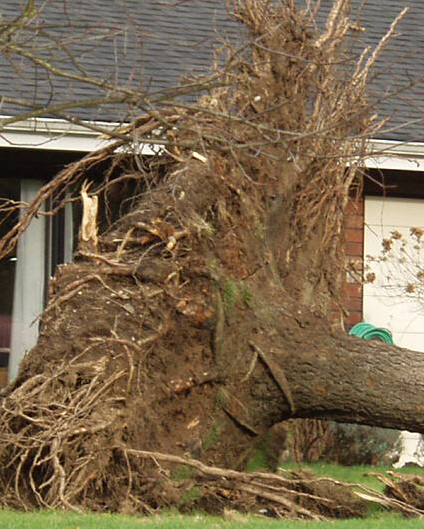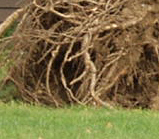| |
How many times have you heard someone say "Those trees have deep tap roots.
They don't need to be watered." There are two parts to this statement
that makes it both correct and wrong.
The correct part is that many types of trees have tap roots that extend down
into the earth below the topsoil. Trees need water during the entire growing
season to have a good year where they are able to generate new seeds for
future trees.
The incorrect part of the above statement
is that the tap roots are a core part of the trees
root sturcture. In a tree's root structure the tap roots
purpose is primarly for bringing in water. A tree needs a complex mixture of
nutrients and minerials to be able to sustain its life and grow.
Trees have most their roots in the first 18" into the soil. The reason for
the high concentration of the roots in the topsoil is that is where the
availability of the nutrients are. Because of this concentration of the roots,
the calculations for amending the soil with nutrients is calculated only to
a depth of the first 12" of the top soil.
Let us take a look at a real example. In the picture below a tree had been
blown down by gale force winds. This process also cause a uprooting of the
tree's roots in the top soil.

The roots still have a lot of the top soil embedded around them. This
photograph shows where the concentration of the roots for this tree were
before it was blown down. You can see some of the roots were broken when
the tree went down. These roots extended out past the primary root mass
to access additional nutrients to support its increasing size. The roots
left in the gound usually die and decompose. Some variety of trees,
such as chestnut trees, will send up new trees from the roots left in the
soil. These new trees are called suckers
There are some commercial growers that propagate their trees using the
roots to send up new trees. There are two chalenges with propagating chestnut
trees using the roots. The first problem is that most commercial nuseries
start their chestnut trees from seed and graft the desire variety to the
seedling. So trees started from the roots are not true to type of the grafted
top. The other problem is removing the "sucker" from the soil is they are
likely attached to a large root and do not have good root structures of their
own. The process of propagating trees from roots is called layering. The
nice thing about layered trees is there is no chance of loosing the top graft
(graft failure) and ending up with some unknown tree with unwanted nut size
or quality.
Chestnut tree roots do not like heavy/clay soils. The more clay in the soil the
less likely the chestnut tree will survive year after year. The soil also has
to be deep. If a clay or rock subsoil structure exists this can also make life
difficult for a chestnut tree. If the soil has a lot of rocks a chestnut tree
will do ok but will need soil amendments to increase the available nutrients.
When planting a chestnut tree always water it when you plant it. The roots
have to have active contact with the soil and only water can provide the
contact sufficient enough to transfer nutrients.
|
|
|
|
Contact Information:
Farm Location:
6160 Everson Goshen Rd
Everson, WA 98247
Ph: (360) 592-3397
Business Offices:
Washington Chestnut Company
6160 Everson Goshen Rd.
Everson, WA 98247
Ph: (360) 592-3397
|
|


